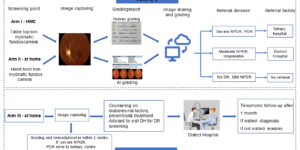Case Report
Abstract
Full TextPDF Introduction: Fetal alcohol syndrome (FAS) is associated with a positive maternal history of drinking during pregnancy and the presence of characteristic dysmorphic features due to alcohol teratogenic effect. No evidence is yet available regarding the use of growth hormone (GH) for children with FAS for whom GH deficiency has not been confirmed.
Case Presentation: We have highlighted an improvement in auxological parameters of a child with FAS and normal GH stimulation tests, using a GH dosage similar to that used in idiopathic GH deficit, without side effects.
Conclusion: GH therapy in children with FAS may lead to an improvement in growth rate and an increase in final height, although, this condition is not included in the specific recommendations for use of GH. Prolonged follow-up and prospective studies are needed to evaluate long-term efficacy and monitor any possible onset of side effects.
Protocol PaperDuggal M*, Chauhan A*, Gupta V, Kankaria A, Sood N, Miglani V, Tigari B, Kaur G, Kumar L, Naveen M, Budhija D, Badada SK and Vale L
Comparing the Implementation of Different Diabetic Retinopathy Screening Models in Primary Health Care Settings in Northern India: Pragmatic Three-Arm Observational Study Read More »
Introduction: Early screening is recommended to prevent vision impairment (VI) and blindness globally due to diabetic retinopathy (DR). We aim to analyze the factors influencing the implementation of DR screening models in primary healthcare facilities.
Methods: A pragmatic three-arm observational study will be conducted in the district of Mohali in Punjab, India. The study will compare three equal-sized groups with type 2 diabetes mellitus (T2DM) at age 30 and above. The T2DM participants and healthcare providers (HCPs) will be interviewed to identify the barriers to retinal examinations in primary healthcare settings. The study includes a comprehensive economic evaluation to determine the cost-effectiveness of implementing different DR screening models in primary health settings. The present study will use the RE-AIM framework (reach, effectiveness, adoption, implementation, and maintenance), to assess the implementation of two DR screening interventions and the extent of variation in outcomes. Qualitative and quantitative data collected from participants and research team observations will be examined to report on the five RE-AIM domains.
Discussion: A screening program should ensure early detection and referral for DR treatment before it results in irreversible vision loss. However, understanding the problems of accessing DR screening and estimating the cost-effectiveness of such programs in a primary health setting is important before allocating public health resources.
Research Article
Abstract
Full TextPDF Objective: Osteoporotic fractures are a major public health problem worldwide. Effective therapies have been available since 1995, with bisphosphonates (BPs) as the most used first-line drugs. Zoledronic acid and denosumab (Dmab) became available soon thereafter. However, both BPs and Dmab, but not other osteoporosis therapies, are associated with rare occurrences of osteonecrosis of the jaw (ONJ) and atypical femur fracture (AFF), the two most common major barriers either for initiating or maintaining effective anti-fracture therapies. In this pilot study, we aimed to determine dentists’ perceptions and practice patterns to mitigate ONJ.
Methods: After approval from the Institutional Review Board, we e-mailed an online 7-point survey questionnaire to licensed dental practitioners, the members of the Michigan Dental Association (MDA), to ascertain the range of approaches dentists would take to treat patients who were using osteoporosis medications.
Results: Members of the MDA were surveyed with a series of questions, and 40 responses were received. Respondents were 50% women, and 28 worked in suburban areas, 8 in urban areas, and 4 in rural areas. 48% of the dentists have been practicing for > 20 years, 32% for 5–20 years, and 20% for < 5 years. When asked about the interruption of osteoporosis medications for low-risk dental procedures, such as cavities, 68% never stopped therapy, 17% stopped in certain scenarios, and 15% reported stopping after a discussion with the patient’s provider. When asked about the interruption of osteoporosis medications for high-risk dental procedures, such as tooth extractions, 15% would not interrupt therapy, 23% would interrupt in certain scenarios, 7% would always interrupt therapy, and 55% would interrupt therapy after discussion with the patient’s provider.
Conclusion: Despite the extreme rarity of ONJ, no specific guidelines exist from the American Dental Association (ADA), and dentists’ perspectives on mitigating ONJ are quite varied. Our study suggests that many dentists feel that osteoporosis therapy is a major barrier to safe dental practice and indicates an urgent need for education of our dentist colleagues on the rationale and validity of interrupting osteoporosis therapies.



